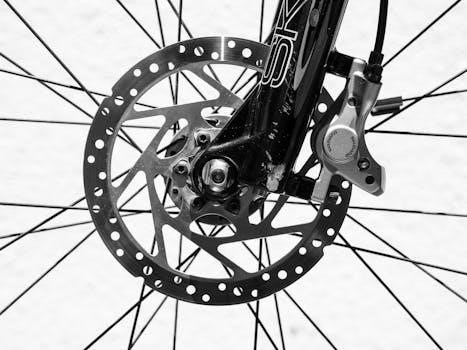Mountain bike wheel sizes are crucial for performance, with 26, 27.5, and 29 inch options. The sizes impact agility, rollover, and traction. This guide helps navigate these choices and their effects on riding.
Understanding the Basics of MTB Wheel Sizing
Mountain bike wheel sizes are primarily measured by their diameter in inches, influencing a bike’s handling and performance characteristics. Initially, 26-inch wheels were the standard, but the introduction of 29-inch (29ers) and 27.5-inch (650b) wheels has diversified the market. These measurements refer to the approximate outer diameter of the tire when mounted on the rim. Understanding these sizes is important because the wheel size directly affects how the bike rolls over obstacles, accelerates, and maintains momentum. The choice of wheel size also impacts the contact patch of the tire, influencing traction and grip. Additionally, the frame geometry and suspension design are often specifically tailored to accommodate each of these wheel sizes, further emphasizing their importance in the overall riding experience. The wheel size you choose should be based on your riding style, the terrain you tackle, and personal preferences.

Common Mountain Bike Wheel Sizes
The most common mountain bike wheel sizes include the legacy 26-inch, the versatile 27.5-inch (650b), and the popular 29-inch (29ers). Each size offers unique handling characteristics for different riding styles.
The Legacy of 26-inch Wheels
The 26-inch wheel size was the original standard for mountain bikes, dominating the market for many years. These wheels are known for their lighter weight and responsive nature, making bikes equipped with them feel nimble and quick, especially on smooth surfaces. They are often praised for their ability to accelerate rapidly and for being more agile in tight, twisty trails. The 26-inch wheels were the go-to choice for cross-country racers and even hard-hitting downhill bikes, showcasing their versatility. However, as mountain biking evolved, larger wheel sizes emerged, leading to a decline in the popularity of the 26-inch wheel, with many modern bikes now favoring 27.5 or 29-inch wheels. Despite this shift, the 26-inch wheel still has a place in the world of mountain bikes, particularly in dirt jump, freeride, and kids’ bikes.
The Rise of 27.5-inch (650b) Wheels
The 27.5-inch wheel, also known as 650b, emerged as a middle ground between the traditional 26-inch and the larger 29-inch wheels, aiming to offer the best of both worlds. This size gained popularity for its enhanced agility and quicker acceleration compared to 29ers, while providing better rollover capabilities than 26-inch wheels. The 27.5-inch wheel has a shallower attack angle than the 26-inch, which leads to smoother transitions over obstacles and uneven terrain. It is often favored by riders who prefer a more nimble handling experience on tight, twisty trails. It also allows for the use of bigger tires, providing additional comfort and a mountain bike-like feel, even on gravel paths. Today, the 27.5-inch wheel is a common choice on many adult mountain bikes.
The Dominance of 29-inch Wheels (29ers)
The 29-inch wheel, often called “29ers,” has risen to dominance in the mountain bike world, especially for cross-country and downhill riding. These wheels are known for their superior roll-over capabilities, allowing riders to easily navigate obstacles and maintain momentum. The larger contact patch of 29-inch tires provides enhanced traction, contributing to better control and stability. While they might not be as quick to accelerate as smaller wheels, 29ers excel in maintaining speed on varied terrains. They are also favored by taller riders for their proportional fit and overall efficiency. The 29-inch wheel has become the standard choice for fast downhill bikes and many other modern mountain bike types, showcasing its widespread appeal and performance advantages.
Comparing Wheel Size Performance
Wheel size affects mountain bike performance significantly. 29ers excel in rollover and traction. 27.5-inch wheels offer better agility. 26-inch wheels are lighter and more responsive, influencing rider experience and suitability.
29er Advantages⁚ Roll-Over and Traction
29-inch wheels, often called 29ers, offer significant advantages in mountain biking, particularly when it comes to roll-over capability and enhanced traction. The larger diameter of these wheels allows them to navigate over obstacles, such as rocks and roots, with greater ease and efficiency compared to smaller wheel sizes. This superior roll-over ability means that a 29er can maintain momentum more effectively, requiring less effort from the rider to clear challenging terrain. Additionally, the increased contact patch of the larger tire enhances traction, providing better grip on loose or slippery surfaces. This results in more confident handling and control, especially when climbing steep inclines or navigating technical trails. The larger wheel size is also known for maintaining speed more effectively, making them a great choice for longer rides and cross-country adventures where efficiency is key. Therefore, these wheels are a preferred option for those seeking improved stability and speed.
27.5-inch Advantages⁚ Agility and Acceleration
The 27.5-inch wheel size, often referred to as 650b, presents notable advantages in terms of agility and acceleration for mountain biking. These wheels strike a balance between the nimbleness of smaller wheels and the roll-over capabilities of larger ones. The reduced rotational inertia of the 27.5-inch wheels allows for quicker acceleration, making them highly responsive to rider input. This responsiveness translates into enhanced maneuverability, particularly in tight, twisty trails where rapid changes in direction are necessary. The smaller diameter also makes it easier to initiate turns and handle technical sections that require quick adjustments. Furthermore, the 27.5 size tends to be lighter than 29-inch wheels, contributing to the feeling of nimbleness and improved climbing ability. This wheel size is a great option for those who prioritize quick handling, efficient acceleration, and a playful ride.
26-inch Advantages⁚ Lighter and Responsive
While less common on modern mountain bikes, 26-inch wheels still offer unique advantages, particularly in terms of weight and responsiveness. Due to their smaller diameter, 26-inch wheels are generally lighter than their 27.5-inch and 29-inch counterparts, resulting in a more agile and nimble ride. This reduced weight makes the bike easier to handle, accelerate, and maneuver, especially on smoother surfaces and tight trails. The smaller size also contributes to quicker acceleration and more direct handling, making them feel very responsive to rider input. The 26-inch wheel’s inherent stiffness due to its smaller diameter can also enhance power transfer, making them ideal for riders who prioritize a lively and playful feel. Although less prevalent today, 26-inch wheels remain a solid option for certain riding styles and preferences.

Other Wheel Sizes in Mountain Biking
Beyond the common sizes, 24-inch wheels appear on some junior mountain bikes and BMX cruisers. These less common sizes cater to specific needs and rider demographics, differing significantly in performance.
The Uncommon 24-inch Wheel
The 24-inch wheel is a less frequently seen size in the adult mountain bike world, primarily finding its place on junior mountain bikes designed for younger riders who are not quite ready for the larger wheel sizes. This size also appears on some BMX cruiser models that cater to larger riders who prefer the geometry and feel of a BMX bike, but with a larger frame and wheel size for increased stability and comfort. These 24-inch wheels offer a balance of maneuverability and stability for smaller frames and riders, making them suitable for specific niches in the market. While not a mainstream option for adult mountain biking, they fill an important role for younger riders and those seeking a unique riding experience.

Wheel Size and Tire Compatibility
Understanding tire width and rim width is essential for optimal performance. Matching tire size to rim width ensures proper fit, handling, and prevents issues. Compatibility charts are useful for this.
Understanding Tire Width and Rim Width Combinations
Selecting the right tire and rim width combination is crucial for optimal mountain bike performance. The internal rim width dictates the range of tire widths that can be safely and effectively used. A tire too wide for the rim may result in a squirmy feel and increased risk of burping, while a tire too narrow can lead to a harsh ride and potential for pinch flats. Understanding the relationship between these measurements allows riders to choose the best setup for their riding style and the terrain they encounter. WTB’s tire and rim compatibility charts are valuable for making informed decisions. Proper combinations enhance grip, handling, and overall riding experience, ensuring a safe and efficient ride. Tire and rim width significantly affect the tire’s profile and its contact patch with the ground.

Choosing the Right Wheel Size
Selecting the correct wheel size depends on riding style and terrain. Consider personal preferences and rider height. There isn’t a perfect size for all, so testing and research are key.
Matching Wheel Size to Riding Style and Terrain
The ideal mountain bike wheel size is heavily influenced by your typical riding style and the type of terrain you frequently encounter. For riders who prefer fast, flowy trails and prioritize speed and efficiency, 29-inch wheels, often referred to as 29ers, are often the preferred choice, because they provide better roll-over capabilities and maintain momentum. On the other hand, if you enjoy more technical trails with tight corners and frequent changes in direction, the agility and responsiveness of 27.5-inch wheels might be more suitable. They offer quicker acceleration and easier maneuverability which is essential for technical riding. Moreover, the legacy 26-inch wheels, known for their nimble nature, can be a good choice for smoother, flat surfaces and for riders who appreciate quicker acceleration. Consider if you prioritize obstacle roll-over, agility, or acceleration when selecting the best option.
Personal Preferences and Rider Height Considerations
Beyond terrain and riding style, personal preference and rider height also significantly affect the optimal mountain bike wheel size. Some riders simply prefer the feel of a certain wheel size, finding it more comfortable and intuitive. For example, some may prefer the stability and roll-over of 29-inch wheels, while others may feel more connected to the trail with the agility of 27.5-inch wheels. Rider height is also a crucial factor. Smaller riders may find 29ers feel unwieldy, and that 27.5-inch wheels offer a better fit and more control. In contrast, taller riders often appreciate the improved rolling efficiency and proportional fit of 29-inch wheels. Ultimately, the best wheel size is the one that feels right for you and your body.
Mountain bike wheel sizes continue to evolve, offering diverse options for various rider needs and preferences. Choosing the right size is key for optimal performance and enjoyment on the trails.
The Evolving World of MTB Wheel Sizes
The landscape of mountain bike wheel sizes has transformed dramatically over the years, moving far beyond the once-dominant 26-inch standard. Initially, 26-inch wheels were the norm, but advancements in technology and rider preferences introduced 29-inch wheels (29ers), which offered improved roll-over capabilities and momentum. This led to a significant shift in the market. Following the 29er revolution, the 27.5-inch (650b) wheel size emerged as a versatile middle ground, attempting to merge the agility of 26-inch wheels with some of the roll-over benefits of 29-inch wheels. The ongoing debate over the “best” size reflects the diverse needs and riding styles within the mountain biking community. Now, riders often encounter a mix of these three sizes, with some even experimenting with “mullet” setups, combining different wheel sizes on the front and rear for specialized performance characteristics. This evolution highlights the dynamic nature of mountain bike technology, where innovation continuously reshapes the riding experience.


